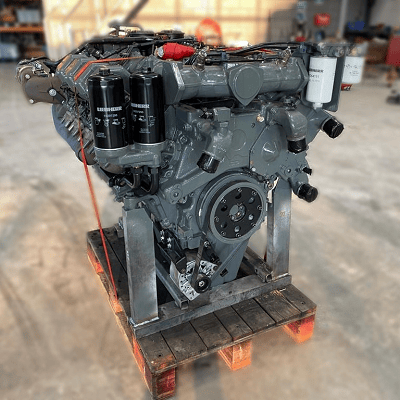The process of a dyno test on a Liebherr engine

When it comes to heavy machinery, reliability and power are paramount. Liebherr, a name synonymous with innovation and excellence in engineering, stands tall as a pioneer in the realm of heavy equipment and machinery. From towering cranes to robust excavators, Liebherr’s engineering prowess extends to the heart of these machines. We delve into the world of dyno testing a Liebherr engine, uncovering the meticulous process behind unleashing the raw power concealed within.
The foundation of excellence
Before we embark on the journey of dyno testing, it’s crucial to understand the foundation upon which Liebherr engines are built. With decades of engineering expertise and commitment to quality, Liebherr engines are crafted to withstand the most demanding environment and deliver unparalleled performance. Each component is meticulously designed and rigorously tested to ensure reliability, efficiency and longevity.
The process
1 Preparation: The engine undergoes meticulous preparation before being mounted onto the dynamo meter. This includes ensuring all connections are secure, fluids are filled to the appropriate levels, and sensors are properly calibrated.
2 Mounting: The engine is carefully mounted onto the dynamometer, a specialized device designed to simulate real-world operating conditions. Precision is paramount during this step to ensure accurate results.
3 Initial checks: Once mounted, a series of initial checks are conducted to verify proper alignment, connection integrity, and functionality of all engine systems.
4 Warm-up: The engine is started and allowed to warm up to operating temperature. This ensures consistent results and minimizes the risk of damage during testing.
5 Baseline testing: With the engine warmed up , baseline tests are conducted to establish initial performance metrics. This includes measuring power output, torque, fuel consumption, and emissions at various RPM levels.
6 Load testing: The engine is subjected to progressively increasing loads to simulate different operating conditions, such as idle, partial load and full load. This allows engineers to assess performance across the entire operating range and identify any potential issues or optimization.
7 Data analysis: Throughout the testing process, data is continuously collected and analyzed in real-time. Advanced instrumentation and software are used to monitor performance metrics and identify trends or anomalies.
8 Optimazation: Based on the data analysis, adjustments may be made to optimize engine performance. This could involve fine-tuning fuel injection timing, adjusting air-fuel ratios, or optimize turbocharger boost pressure.
9 Validation: Once testing is complete, the results are meticulously reviewed and validated against predetermined criteria and specifications. Any deviations or anomalies are thoroughly investigated to ensure accuracy and reliability.
10 Reporting: Finally, a comprehensive report is generated detailing the results of the dyno testing, including performance metrics, observations, and any recommendations for further optimization or refinement.
The outcome of dyno testing
Dyno testing a Liebherr engine is more than just a routine procedure – it’s a testament to the unwavering commitment to excellence that defines Liebherr’s engineering philosophy. By subjecting their engines to rigorous testing and analysis, Liebherr ensures that each engine delivers the uncompromising performance, reliability, and efficiency that customers expect.
In conclusion, dyno testing a Liebherr engine is not just about measuring power output. It’s about unlocking the true potential of these remarkable engines and ensuring they exceed expectations in the most challenging environments imaginable.
Construction Hoist Electrical Parts
Some common electrical parts used in construction hoists include:
1. Control panel: This is the main electrical component that allows the operator to control the movement of the hoist. It typically includes switches, buttons, and indicators for various functions such as raising, lowering, and stopping the hoist.
2. Motor: The motor is responsible for providing the power to operate the hoist. It converts electrical energy into mechanical energy to lift and lower the load.
3. Limit switches: These switches are used to set the upper and lower limits of the hoist's movement. They help prevent the hoist from overtraveling and causing damage.
4. Emergency stop button: This is a safety feature that immediately stops the hoist's operation in case of an emergency or malfunction.
5. Overload protection: This is a safety mechanism that automatically stops the hoist if it exceeds its maximum load capacity. It helps prevent accidents and equipment damage.
6. Electrical cables and wiring: These components connect the various electrical parts of the hoist, allowing for the transmission of power and control signals.
7. Circuit breakers and fuses: These protective devices are used to prevent electrical overload and short circuits. They automatically cut off the power supply in case of excessive current flow.
8. Voltage regulator: This device ensures a stable and consistent supply of electrical power to the hoist, protecting it from voltage fluctuations.
9. Sensors: Various sensors, such as proximity sensors or limit switches, are used to detect the position, speed, or presence of objects in the hoist's path. They provide feedback to the control system and help ensure safe and efficient operation.
10. Wiring connectors and terminals: These components are used to connect and secure the electrical wires in the hoist, ensuring reliable and safe connections.
The specific electrical parts used in a Construction Hoist may vary depending on the manufacturer and model. It is always recommended to refer to the hoist's user manual or consult with a professional for accurate information.
Construction Hoist Motor,Construction Hoist Limit Device,Construction Hoist Electric Parts,Construction Hoist Reducer,Sliding Contact Line
SHEN YANG BAOQUAN BUSINESS CO., LTD , https://www.sytopkittowercrane.com